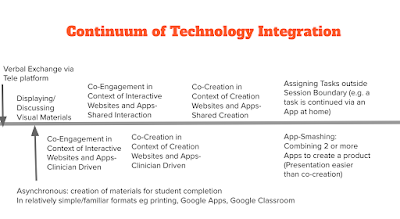For that reason, I've added to the left/simpler side of that continuum so that it now looks like this:
...acknowledging the importance and value of those easy-to-execute, conversational activities.
Elaborating on the verbal exchange and asynchronous types of activities are examples of conversational games/structured conversations like "high and low" (state the high of your week and low of the week, essentially two narratives or one linked with an adversative but for the low).
I find it valuable to screenshare to provide visual support and structure for some of these, but you could do that with a small whiteboard on camera, too.
One of my favorite conversational games is Two Truths and a Lie. This requires some planning when playing- what 3 things should I say? One strategy I always teach is to think of three true things and then change one slightly. On players' part there is a lot of listening and responding needed. This game also is a good way to work on the Social Thinking® concept of "People Files"- it's expected to remember things and show interest about others, and your social memory of others will help you start conversations. The mnemonic here of FILE is my own creation- what's the schema of what we remember about people. I always think of likes/dislikes as separate from interests e.g. I should remember he's a Sooners fan, he hates seafood, etc.
Playing in tele I found this visual support helpful both to aid in comprehension (write down the players' statements as they say them) and the flow of the game. It's good to hand the responsibility of "polling" to the person who makes the statements, and when you are not sitting in a circle, writing the students' names assists so they can "call" on each other for guesses (in person I encourage them to do this with eye gaze but that doesn't work so well in teletherapy. Also this is a visual aid for learning names, often a challenge.
Anyone have other "conversation games" they like to play that require minimal materials? Please let us know in the comments!

